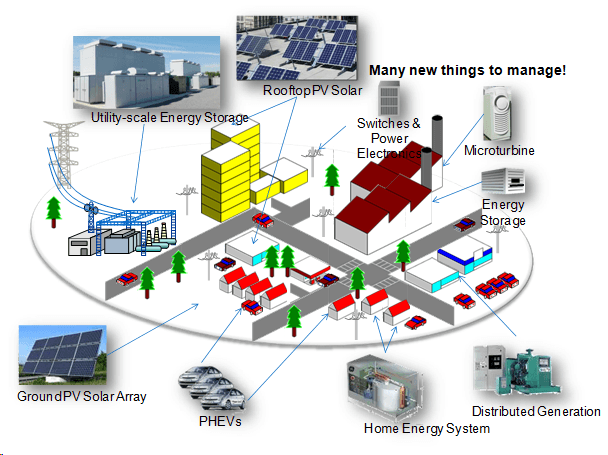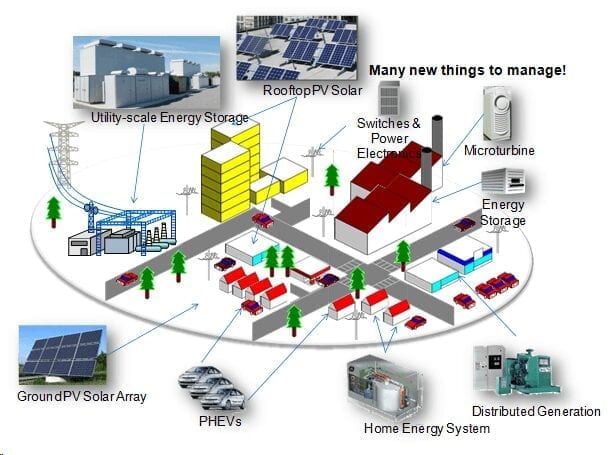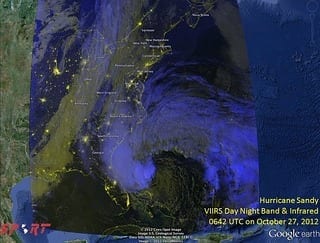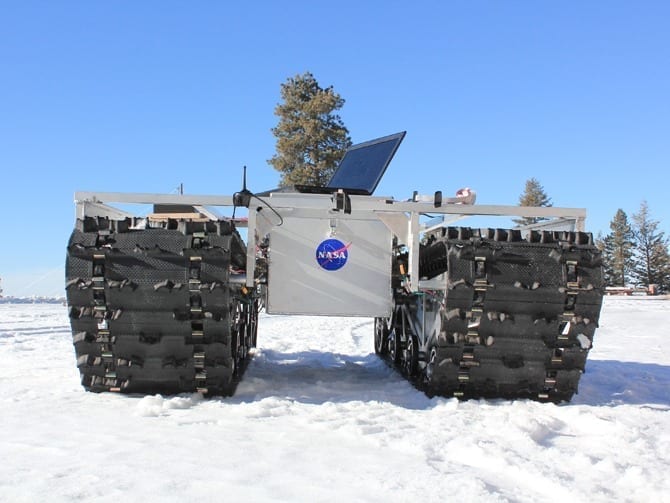
Backup generators and islanded mini-grids helped some parts of New York City keep the lights on after Hurricane Sandy
In the wake of Superstorm Sandy, when most of lower Manhattan was a sea of darkness, New York University’s Washington Square campus shone like a beacon in the night.
“The entire neighborhood was dark — everything. And then there was us,” said John Bradley, NYU’s assistant vice president of sustainability, energy and technical services. “It really was a little surreal.”
Swaths of Manhattan below 36th Street were powerless after Sandy hit, due to pre-emptive shutdowns and severe flooding that knocked out a power station in the East Village. But key buildings on NYU’s campus stayed alight thanks to a self-sufficient microgrid system, designed to distribute electricity independently of Consolidated Edison Inc.’s main grid network.
A 13.4-megawatt combined heat and power (CHP) plant — made up of two giant natural gas-fired turbines housed below Mercer Street — powers the university’s 26 electrically connected buildings. It also provides hot and cold water for up to 40 buildings by harnessing waste heat that would otherwise be released into the atmosphere. The efficient CHP facility produces 30 percent less greenhouse gas emissions than the oil-fired power plant it replaced.
In response to Superstorm Sandy, which made landfall last Oct. 30, leaders at all levels of the U.S. government have identified microgrids like the one at NYU as key components to improving energy resiliency on the East Coast. A recent federal report by the Hurricane Sandy Rebuilding Task Force cites microgrid systems as a means of mitigating the sprawling impacts of disasters fueled by climate change.
There’s no official definition of a microgrid, but they’re generally considered to be self-contained grid systems equipped with on-site power generation, like a CHP plant or a renewable resource like wind or solar. As isolated entities, microgrids can keep operating — and, in NYU’s case, keep students safe and power flowing to research projects — even in the event of a large-scale power outage.
The Latest Bing News on:
Microgrids
- Great Quotations in Charm City: Notable Quotes from Microgrid Knowledge 2024 Conference in Baltimoreon May 7, 2024 at 11:42 am
So we thought we would display a few of the most quoted quotes from Microgrid Knowledge 2024. For those who came we were thrilled to have you there. For those who couldn’t, ...
- Vietnam Energy Storage Battery for Microgrids Market Size Explorer Navigating Untapped Opportunities for Growthon May 6, 2024 at 3:14 pm
Vietnam Energy Storage Battery for Microgrids Market” report, published by Report Ocean, presents a comprehensive analysis of the product’s/service industry, examining both historical patterns and ...
- TIGON project: pioneering microgrids to bridge legacy AC grids and DC outputon May 6, 2024 at 9:01 am
Science X is a network of high quality websites with most complete and comprehensive daily coverage of the full sweep of science, technology, and medicine news ...
- DOE Awards $2.5 Million to Create New Cybersecurity Center To Protect Grids Integrated With Renewables, Microgridson May 3, 2024 at 4:01 pm
The DOE also awarded $15 million to establish six university-based centers to address a region’s unique cybersecurity and workforce training needs.
- 50 states of grid modernizationon May 3, 2024 at 9:14 am
North Carolina Clean Energy Technology Center's recent report looks at how states are doing with legislative and regulatory action related to shoring up the power grid.
- Midstate company, non-profit create solar-powered microgrids for disaster relief effortson May 2, 2024 at 4:49 pm
In total, 18 people were killed.That disaster left tens of thousands without electricity and forced emergency responders to rely on small, gas generators to power disaster relief centers.Now, 14 years ...
- East GB microgrids set to hire up to 50on May 1, 2024 at 9:08 am
# Up to 50 workers will be hired for the proposed build-out of five solar microgrids designed to help “ease cost of living concerns” and entice former residents to return to Dorian-ravaged east Grand ...
- East GB microgrids set to hire up to 50on April 30, 2024 at 5:00 pm
Up to 50 workers will be hired for the proposed build-out of five solar microgrids designed to help “ease cost of living concerns” and entice former residents to return to Dorian-ravaged east ...
- Think Microgrids Are Too Complicated? Schneider Takes on the Problem with a New Battery as its Latest Stepon April 26, 2024 at 8:11 am
Schneider Electric previewed a new battery energy storage system (BESS) at the Microgrid Knowledge conference that aims to make microgrids easier for those who lack ...
- Schneider Electric launches new storage systems for microgridson April 26, 2024 at 7:27 am
The France-based group said its has released two new BESSs with enclosures of 7ft and 20ft. Their power ranges from 60 kW to 500 kW.
The Latest Google Headlines on:
Microgrids
[google_news title=”” keyword=”Microgrids” num_posts=”10″ blurb_length=”0″ show_thumb=”left”]
The Latest Bing News on:
Self-contained grid systems
- AECOM joint venture to deliver the UK National Grid’s Great Grid Upgradeon May 8, 2024 at 3:55 am
AECOM (NYSE: ACM), the world’s trusted infrastructure consulting firm, today announced that its joint venture with Arup has been appointed as a design and consenting service partner for the UK ...
- 'Lost' satellite finally found after orbiting undetected for 25 yearson May 5, 2024 at 5:00 pm
The Infra-Red Calibration Balloon (S73-7) satellite had gone off the grid from radar not once but twice ... It was originally contained in what was called "The Hexagon System" in which S73-7, the ...
- Future Self-Driving EVs Must Plug Themselves In. How Will They?on April 29, 2024 at 7:56 am
Cars that go charge themselves are the ideal, and also a solution for the power grid, plugging themselves in when solar power is surplus and cheap ...
- Sanitation solution developed for underserved communities, schoolson April 25, 2024 at 3:02 pm
The self-contained, off-the-grid toilet system achieves 100% recycling within a closed circuit using a natural biological process to treat wastewater and eradicate pathogens. It operates independently ...
- High exhibitor interest in EnergyDecentral shows the relevance of the exhibition’s topics−renewable−energyon April 24, 2024 at 5:11 am
Leading trade fair for sustainable energy production to take place alongside EuroTier exhibition and Inhouse Farming Feed & Show – DLG Spotlight ...
- How Much Does Well Pump Installation And Replacement Cost In 2024?on April 13, 2024 at 5:44 pm
Well size is one of the biggest factors, but also important to consider are the type of pump, the depth of the well and whether you have pressure tank issues in an existing system. Jet pumps are ...
- Single-Level Tiny With Smart Storage Is a Fabulous Take on Self-Sufficient Livingon April 8, 2024 at 4:54 am
Photo: Taha Tiny Homes Turning the self-contained Luxx into a fully off-grid home is optional ... certificates for both the electrical and gas systems, and you have a sturdy, fully functioning ...
- 8 of the best luxury homes for sale across the countryon March 26, 2024 at 12:51 pm
We’ve rounded up our pick of the bunch from across the country’s most luxurious properties.
- The Story of Indiaon December 23, 2023 at 10:37 pm
Until the modern age they have remained largely self-contained, endogamous (marrying within the tribe), physically distinctive in appearance and outside the Hindu caste system. Many retain their ...
- Why isn't Texas on the national power grid? And answers to other questions about the state's grid.on June 21, 2023 at 4:20 pm
If you’re a long-timer, you probably still have questions about aspects of the system that delivers ... of its power is from ERCOT’s self-contained grid. The eastern and western halves of ...
The Latest Google Headlines on:
Self-contained grid systems
[google_news title=”” keyword=”self-contained grid systems” num_posts=”10″ blurb_length=”0″ show_thumb=”left”]











